It’s well known that I like to go out to thrift shops around in Memphis hunting for things that may be useful, or otherwise interesting to own . While I was out on one of these hunts in late 2016 I stumbled across something that I originally thought was some kind of older computer printer. At first glance it certainly seemed the part, and it was back in the “electronics section of the store. I investigated the item and realized quickly what it was – a typewriter. More correctly, a very modern electronic typewriter, that’s basically a daisy-wheel printer with a keyboard and a bit of computer hardware acting as a bridge.
Specifically, this machine – the Brother SX-4000.
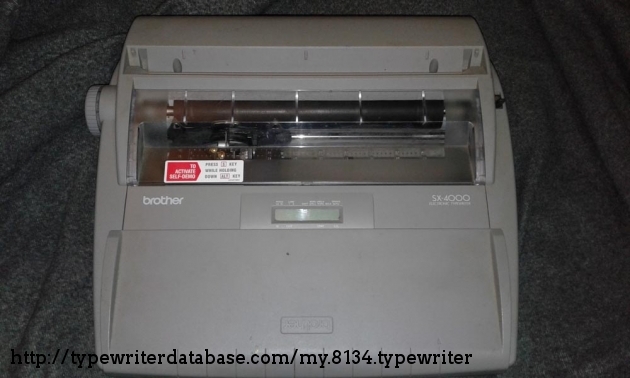
My 1st machine, as shown on typewriter database
I thought to myself “Well, this could be interesting to have.” Everything looks to be there, it worked, all it was missing was the carbon-film ribbon that it uses for printing, and for under $10, it was well within my budget for something to random, so, I bought it, took it home, and then ordered ribbon for it.
I figured it would be useful, rather than the normal process of printing something typed on a computer – I rather hate most PC printers, and buying ink is a relatively expensive pain in the ass, plus if I ever just wanted to sit down and type up a story or something, this would be a nice distraction-free method of doing so, and besides, the thing was just neat!
Well, I never actually used that machine as much as I intended to. I got the ribbon, typed up a few things, but due to a lack of open desk space in my room I didn’t use that machine near as much as I intended.
Perhaps a week or so later, at the same thrift store, I would find another typewriter – this time a 1970’s manual one, also made by Brother, I estimated in the 1970’s based on it’s odd mustard-yellow color. it was missing an ink ribbon as well, and while I thought it was neat to have, I didn’t think much on ordering ribbon for it, content with the other, electronic machine and figuring I wouldn’t use a manual typewriter much. I still didn’t quite have much free space anyway for a machine, other than moving my computer keyboard and using this desk.
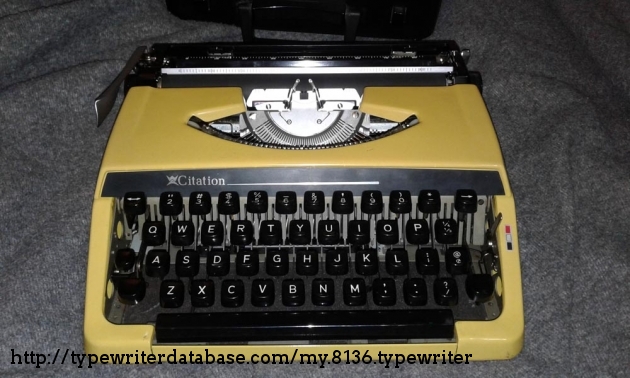
My 2nd typewriter, my 1978 Brother Citation, also as shown on typewriter database.
I would in early 2017 be given a table by a friend who was moving – this proved perfect for me to sit at with a the Brother SX-4000 and type away on, which was fine with me. I typed a few things with it but still didn’t get too “into” things, just typing a bit when I felt like it, but at least I now had a space to really take advantage of.
Then came one of my many trips to Goodwill in mid March of 2017, just shy of a year ago. in the nightmare that is the “bargain barn” on the side of the store I noticed what looked like a large luggage case, but it was oddly heavy. I wondered what was in it, so I did what anyone would do – I opened it up. Inside was a 1960’s Smith-Corona typewriter that just looked awesome. Just below it was another typewriter, similar style but electric, in a different, plastic case. I decided “what the hell” and grabbed both of them for $5 each.
This would be the moment that would change things, and turn me into a collector.
Both machines still had ribbons in them. While the manual one used a standard type of ink ribbon that was rather dry, the electric one used a carbon ribbon similar to the Brother SX-4000 I had gotten months before. I gave them both a bit of a use, and found that I really enjoyed the manual machine. Even though it was somewhat faded, the typing impressions were still good enough to be read, and the quality was good enough that I felt like doing something special.
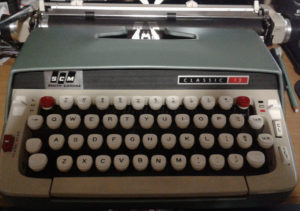
My SCM Classic 12, the machine that really started it all.
I was overdue for sending out a proper thank you letter to a friend for inviting me to her wedding, and so I set out to type that up and mail it to her, knowing she and her husband would greatly appreciate the nature of such a document, as opposed to something printed from a computer, or just sent via email or Facebook messenger.
I was correct in my assumption – she loved the letter, and I had realized that I really enjoyed these machines. In the time since I found the ones at Goodwill, I began reading up on not only those machines, but others, studying their history and browsing all the models that were out there. I knew I wanted more, and had grown to decide a few of them are machines I just had to have!
I began hitting up antique stores more and more, while continuing to do the usual thrift store hunts. I would quickly begin buying new machines every few weeks. Some machines I wound up getting and not liking, and there are a few I outright regret buying all together, but for the most part my collection is all fully functional machines in very good shape which I use quite regularly, give or take the individual machine.
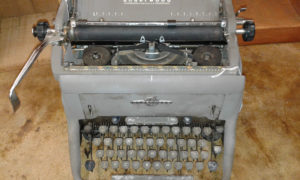
Would you believe this nasty Underwood SX actually cleaned up incredibly well, and is one of my main writing machines?
I’ve actually been lucky enough to find many machines that I did want locally – the Olivetti Lettera 32, the IBM Selectric II, Olympia SM-9, and even a 1940’s Smith-Corona that just looks amazing, they all somehow showed up at just the right time for me to bring home.
It’s a rather unique experience to use a Typewriter, especially one of the old classic manual machines. It’s an art that’s long gone in day to day life, with people often times unable to operate the machines at all when they first run across one – if you’ve seen one in the wild, there is no doubt that you saw it with the typebars jammed as some kid figured they could just mash away like they do on their laptop and get the same result.
They are machines that are oddly soothing for me to use, in how physical they are – how real everything is. The act of putting the paper in, lining things up, then finally pressing the keys, watching them slam into the ribbon, the paper, the platen, and leave their imprint is so satisfying. Very therapeutic in some ways, too.
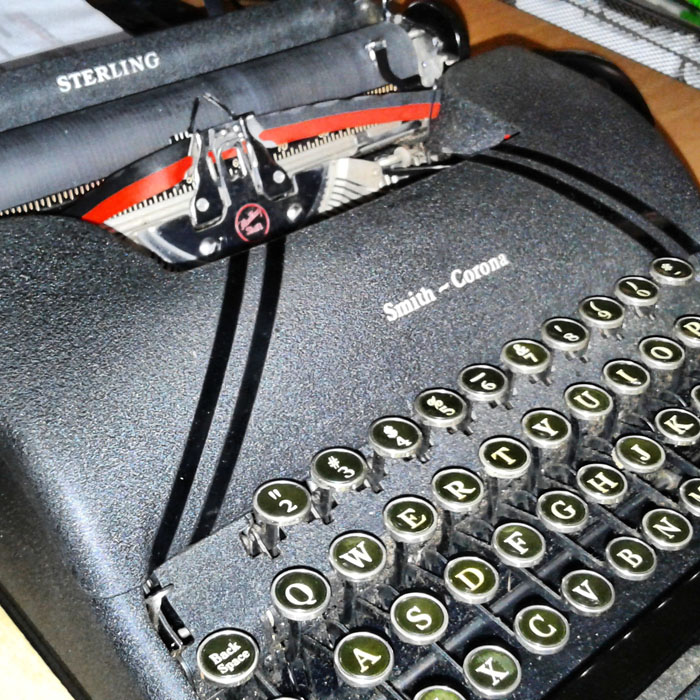
My 1947 Smith-Corona Sterling, an absolute beauty!
Then comes thinking about the age. While a game console like the Atari 2600 seems ancient being from the late 70’s, that’s the same vintage as many of the youngest typewriters in many people’s collections – a majority of typewriters date well back to the 60’s, 50’s, 40’s, 30’s, or earlier depending on just what you can find. It’s strange to use something that’s literally older than your grandparents that works just as it did back when it was new, and was purchased by someone who certainly is no longer alive.
In all the collecting and hunting, there was one machine that I really did want more than any other – a Smith-Corona design from the 1930’s with a flat-top, similar to a piano, as compared to the normal styles of the day. It’s not much different from another machine I already have, but still is unique (and beautiful) enough to warrant my desire – basically a “dream machine” much like some have a dream car.
I finally got one, after a year of hoping I’d run across one in the wild. I had to order it from eBay but I did indeed get it, and it’s everything I expected it to be and then some. That’s the item that was in the package that I mentioned in a previous article, what I would find out is a 1936 Smith-Corona Standard, and is now the queen of my collection.
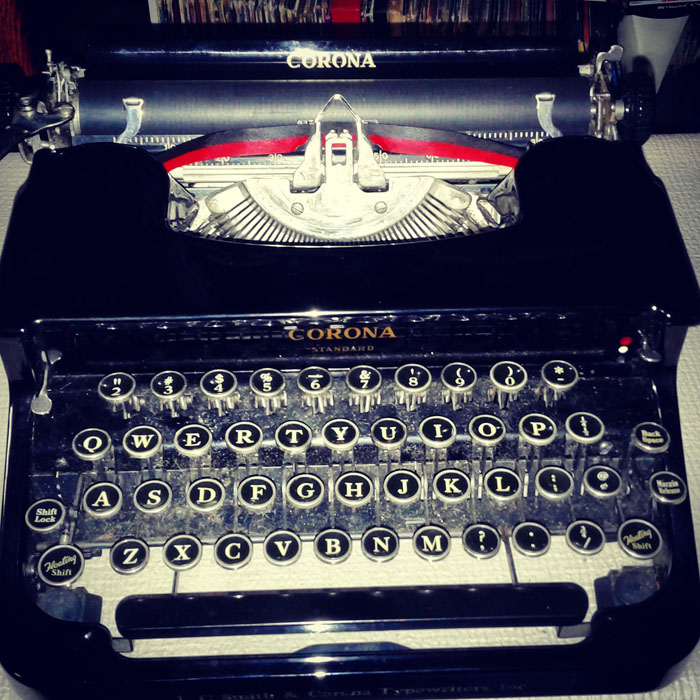
My 1936 Smith-Corona Standard, the queen of my collection!
I have quite a bit more to say about typewriters, and will as time passes, in conjunction with what I normally writer about.
